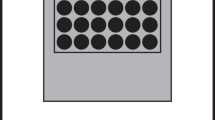Abstract
Small benthic fish such as darters are frequently collected for stream inventory purposes or to document habitat use, with the intent of releasing the fish unharmed following enumeration. The purpose of this study was to examine the injury and short term mortality (8 d) of greenside darters captured by live wire pot trapping and electrofishing, using two different settings (80Hz, 6ms and 60Hz, 6ms). Two different electrofishing techniques were used, spot electrofishing and sweep electrofishing. Short term mortality was highest for fish collected in live pot traps. Abrasion from the wire traps appeared to remove scales and irritate the skin. By the conclusion of the study, 74% of the fish caught in live pot traps were dead from fungal lesions. Greenside darters captured by all electrofishing methods exhibited low short term mortality (< 10%). The only initial mortality, hemorrhaging and spinal damage, occurred for fish collected using 80Hz, 6ms sweep technique, although the short term mortality was still far less than that observed among trapped fish. The spot electrofishing technique resulted in no injury, with either of the settings. Live trapping produces little initial mortality, and thus may be wrongly viewed as a safe alternative for the collection of threatened benthic stream fishes, compared to electrofishing. We suggest that researchers studying small fish in warmwater systems use caution when collecting and handling fish for subsequent release.
Similar content being viewed by others
References
Bagenal, T., 1978. Methods of Assessment of Fish Production in Fresh Waters. Blackwell Scientific Publ., London: 365 pp.
Bohlin, T., S. Hamrin, T. G. Heggberget, G. Rasmussen & S. J. Saltviet, 1989. Electrofishing - Theory and practice with special emphasis on salmonids. Hydrobiologia 173: 9–43.
Bovee, K. D. & T. Cochnauer, 1977. Development and evaluation of weighted criteria, probability of use curves for instream flow assessment: fisheries. U.S. Fish & Wildlife Service. FWS/OBS-77/63.
Bunt, C., S.J. Cooke & R.S. McKinley, 1998. Creation and maintenance of habitat downstream from a weir for the greenside darter (Etheostoma blenniodes) - a rare fish in Canada. Envir. Biol. Fish. 51: 297–308.
Culp, J. M & N. E. Glozier, 1989. Experimental evaluation of a minnow trap for small lotic fish. Hydrobiologia 175: 83–87.
Gammon, J. R., 1976. The fish populations of the middle 340 km of the Wabash River. Purdue University Water Resource Centre Technical Report 86.
Gatz, A. J. Jr., M. J. Sale & J. M. Loar, 1987. Habitat shifts in rainbow trout: competitive influences of brown trout. Oecologia 74: 7–19.
Hearn, W. E. & B. E. Kynard, 1986. Habitat utilization and behavioural interaction of juvenile Atlantic salmon (Salmo salar) and rainbow trout (S. gairdneri) in tributaries of the White River of Vermont. Can. J. Fish. aquat. Sci. 43: 1988–1998.
Heggenes, J., A. Brabrand & S. J. Saltviet, 1990. Comparison of three methods for studies of stream habitat use by brown trout and Atlantic salmon. Trans. am. Fish. Soc. 119: 101–111.
Hendricks, M. L., C. H. Hocutt & J. R. Stauffer, Jr., 1980. Monitoring of Fish in Lotic Habitats. In: Hocutt, C. H. & J. R. Stauffer, Jr. (eds), Biological Monitoring of Fish. Lexington Books, Lexington (Massachusetts): 205–231.
Keenleyside, M. H. A., 1962. Skin-diving observations of Atlantic salmon and brook trout in the Miramichi River, New Brunswick. J. Fish. Res. Bd Can. 19: 625–634.
Larimore, R. W., 1961. Fish population and electrofishing success in a warm-water stream. J. Wildl. Mgmt 25: 1–12.
Neish, G. A. & G. C. Hughes, 1980. Fungal diseases of fish. In Snieszko, S. F. & H. R. Axelrod (eds), Diseases of Fishes, Book 6. T.F.H. Publications, Neptune, (New Jersey): 159 pp.
Northcote, T. G. & D. W. Wilkie, 1963. Underwater census of stream fish populations. Trans. am. Fish. Soc. 92: 146–151.
Reynolds, J. B., 1996. Electrofishing. In Murphy, B. R. & D. W. Willis (eds), Fisheries Techniques, 2nd edn. Am. Fish. Soc., Bethesda (Maryland): 221–253.
Richards, R. H., 1978. The mycology of teleosts. In Roberts, R. J. (ed), Fish Pathology. Bailliere Tindall, London: 205–215.
Tiffney, W. N., 1939. The host range of Saprolegnia parasitica. Mycologia 31: 310–321.
Whaley, R. A., O. E. Maughan & P. H. Wiley, 1978. Lethality of electroshock to two freshwater fishes. Prog. Fish-Cult. 40: 161–163.
Willoughby, L. G., 1969. Salmon disease inWidermere and the river Leven: The fungal aspect. Salmon Trout Mag. 186: 124.
Wolke, R. E., 1975. Pathology of bacterial and fungal diseases affecting fish. In Ribelin, W. E. & G. Migaki (eds), Pathology of Fishes. The University of Wisconsin Press, Madison (Wisconsin): 33–116.
Rights and permissions
About this article
Cite this article
Cooke, S.J., Bunt, C.M. & Scott McKinley, R. Injury and short term mortality of benthic stream fishes – a comparison of collection techniques. Hydrobiologia 379, 207–211 (1998). https://doi.org/10.1023/A:1003288117978
Issue Date:
DOI: https://doi.org/10.1023/A:1003288117978




